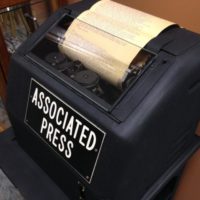I purchased this camera back in January but a busted arm and cold weather prevented me from plunging in as I usually do with a new toy. Additionally, I found myself overwhelmed by the number of features and settings. All excellent features, but there are so many of them. I couldn’t find a place to start. So yesterday I turned the camera on and headed into the woods, paying to attention to settings. The video below was shot at 1080/30fps. I’ve reset to 4K/60fps for the next shoot. Watch this space. (PS: A YouTube search will tell you all you might want to know about this little gadget.)
Category Archives: Video
Audigo Microphone
I’ve been using the Audix USB 12 microphone to record the audio for videos for a long time. Ten years? Sounds good but keeps me tethered to my MacBook which hasn’t been an issue for most of my stuff. But, occasionally, I’ve thought it would be fun to put the video camera (laptop or iPhone) further away. But then the audio suffers.
The first video below is a demo of the Audigo Microphone and app. The short video below that is my attempt to show the difference audio quality. Eager to try this out with a new uke song.
UPDATE: Sample (:50) off video recorded from across the room with audio from the Audigo mic.
More playtime
What is an office?
DJI Avata
The virtual reality thing (as I understand it) hold no appeal for me. But I would be willing to strap on some goggles for a drones-eye-view of some interesting place. This is already a thing, yes?
My friend George recently got his hands on the DJI Avata, a pricey ($1388) little drone you fly with goggles and a joystick.
Reminiscent of William Gibson’s simstim. “…recorded sensoriums, like racing a black Fokker ground-effect plane across the Arizona mesa tops; diving the Truk Island preserves.”
74
Today is my 74th birthday. I’ve never been one for big celebrations. I struggle to see anything special about the day. A cultural thing, perhaps… like Valentine’s Day or Memorial Day. I thought I’d be wiser by this time, depending on how one defines wisdom.
When I think about the future these days, it tends to be in years rather than decades. Mortality and death are no longer abstractions. For the last dozen years I’ve viewed god and the universe through the lens of Buddhism and zen. I’ve concluded the self and free will are illusions. In short, this is It. William Gibson said it nicely in All Tomorrow’s Parties:
“He, like everyone else, is exactly where, exactly what, exactly when he is meant to be. It is the Tao.
PS: The clip below was floating around, unattached, in the media library and this seemed like a good place to park it.
We’re In the Money
The original post got lost somewhere along the way and this clip from Gold Diggers of 1933 is one of my favorites. Ginger Rogers sining in pig latin? Oh yes.
Understanding Technology (Time Bandits)
Low water bridge following today’s rain
Wire Service
I recall visiting the radio station where my father worked and standing in front of the Associated Press teletype, entranced by the endless stream of words. Who was typing? Where were they? Did they ever stop?
Years later, as a young man, I got a job at the station and came to depend on the AP “wire.” It was our only link to real-time (I’m not sure that phrase even existed in 1972) news and information from outside our little town. The daily newspaper was tossed on the doorstep every afternoon (or you could get the Memphis paper a day late). The three national TV networks gave us a half-hour of national news each evening.
 Our radio station didn’t have a national news network (until 1974) so we relied on the Associated Press newswire for just about everything throughout the day. During a live “board shift” we would dash to the AP teletype (in the transmitter room) and “rip the wire” which involved tearing a long strip of printed wire copy into piles of news, weather, sports, entertainment news, etc. If the paper jammed or the ribbon broke, we missed whatever was fed. If something the AP considered urgent was fed, an alarm bell on the teletype sounded.
Our radio station didn’t have a national news network (until 1974) so we relied on the Associated Press newswire for just about everything throughout the day. During a live “board shift” we would dash to the AP teletype (in the transmitter room) and “rip the wire” which involved tearing a long strip of printed wire copy into piles of news, weather, sports, entertainment news, etc. If the paper jammed or the ribbon broke, we missed whatever was fed. If something the AP considered urgent was fed, an alarm bell on the teletype sounded.
A radio station had to have a wire service. Without it they were limited to playing records and reading local news and school lunch menus. The AP knew this and charged accordingly. Thousands of dollars a year. Contracts were for five years. But there was no alternative.
In 1984 I left the radio station to take a job managing The Missourinet, a statewide news network originating from Jefferson City, Missouri. I worked for (parent company) Learfield Communications for the next 28 years. One of the more interesting projects I worked on was the creation of a low-cost alternative to the Associated Press. We called it Learfield Data (later, Learfield Newswire).
I worked on this (along with bunch of other people) for a dozen years from the late ’80s through 2000. At one time we had 300 subscribers. When the World Wide Web became a reality in the mid-90s it was clear the days of wire services were numbered. Road kill on the Information Highway. You can read the story of how it began and ended here.
